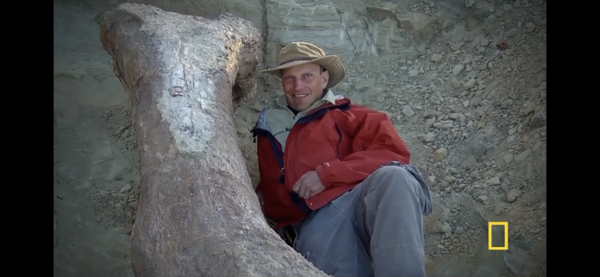Rowan paleontologist, discoverer of Dreadnoughtus, featured on National Geographic’s “Drain the Oceans” program
Rowan paleontologist, discoverer of Dreadnoughtus, featured on National Geographic’s “Drain the Oceans” program

Dreadnoughtus was among the biggest dinosaurs that ever lived. And though it ate only plants, it wielded a tail that could kill any would-be predator.
Dr. Kenneth Lacovara, founding dean of Rowan University’s School of Earth & Environment and founding executive director of the Jean & Ric Edelman Fossil Park & Museum in Mantua Township, detailed his 2005 discovery of Dreadnoughtus and the years long process of finding, excavating, reassembling and mapping the dinosaur, on an episode of National Geographic’s “Drain the Oceans” program, “Secrets of the Dinosaurs,” March 19.
Through 3-D animation, CGI and other 21st century techniques, the program explained how Lacovara in 2004 set out to find not just an undiscovered specie of dinosaur, but a Titanosaur.
“I wanted to find creatures that were among the largest to ever walk the face of the earth,” he said.
Seeking a dinosaur? Look where no one else has been
Lacovara explained on the program that paleontologists start searching for dinosaurs by locating rocks from when the animals lived, “rocks at least 66 million years old.”
He narrowed his search to southern Patagonia in Argentina, a vast body of land the locals sometimes call “fin del mundo, the end of the world.” It’s a sparse, beautiful region, but so remote, he said, that “no other paleontologists had been working within maybe 1,000 kilometers… You get yourself on the ground and you just walk, and you look for bones sticking out of the ground.”
Lacovara’s team had been in Patagonia for nearly a year when they found something, “a piece of exposed bone that had weathered out of a cliff face… We knew that we were looking at one of the largest dinosaur bones that had ever been seen.”
Unfortunately, he said, the rest of that particular animal’s bones were not preserved. The good news was that if there was one bone, there were likely many more “and that was enough for us.”
Returning with a larger expeditionary crew the following year, Lacovara’s team struck pay dirt, but it took four more years to recover about 70 percent of the fossil skeleton.
In all, recovering the fossil Lacovara would name Dreadnoughtus, “fears nothing,” took about five years but it would reveal a previously unknown Titanosaur of breathtaking length, height and mass.
“This animal would have been 85 feet long, almost the size of a basketball court,” he said.
One of the first dinosaur fossils to be fully captured on a 3D digital scan, Dreadnoughtus evolved with a massive, muscular tail “that could kill or maim the largest predators,” he said.
Dr. Aja Carter, Lacovara’s former student and now a paleo-roboticist at the University of Pennsylvania, worked with Lacovara in the lab, on the long and painstaking process of extricating bone from rock.
“It’s really slow, but I love it,” she said.
Said Carter, “it wasn’t that it was so big that something couldn’t eat it, it’s that it was weaponized in case something did try.”
To learn more about the full discovery, unearthing, “jacketing” and assembly of Dreadnoughtus, watch National Geographic’s “Secrets of the Dinosaurs” program, which may be streamed via most popular TV providers including Version FIOS, Comcast and YouTube TV.
Fossils closer to home
Lacovara is currently leading a project of perhaps even greater consequence for Rowan University, southern New Jersey, and generations of citizen scientists: the construction of an all new, interactive $75 million museum at the Jean & Ric Edelman Fossil Park. A grand opening of this world-class facility is planned for spring of 2024.